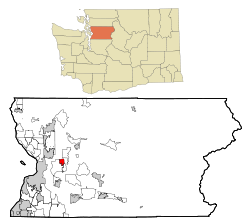Lake Stevens
| Lake Stevens, Washington | |
|---|---|
| City | |

Northeast shore of lake on which the city is located
|
|
| Motto: "One community, around the lake" | |
 Location of Lake Stevens, Washington |
|
| Coordinates: 48°1′11″N 122°3′58″W / 48.01972°N 122.06611°WCoordinates: 48°1′11″N 122°3′58″W / 48.01972°N 122.06611°W | |
| Country | United States |
| State | Washington |
| County | Snohomish |
| Area | |
| • Total | 8.90 sq mi (23.05 km2) |
| • Land | 8.88 sq mi (23.00 km2) |
| • Water | 0.02 sq mi (0.05 km2) |
| Elevation | 217 ft (66 m) |
| Population (2010) | |
| • Total | 28,069 |
| • Estimate (2015) | 30,886 |
| • Density | 3,160.9/sq mi (1,220.4/km2) |
| Time zone | Pacific (PST) (UTC-8) |
| • Summer (DST) | PDT (UTC-7) |
| ZIP code | 98258 |
| Area code | 425 |
| FIPS code | 53-37900 |
| GNIS feature ID | 1512695 |
| Website | www.lakestevenswa.gov |
Lake Stevens is a city in Snohomish County, Washington, United States named after the lake that it is built around. It is southeast of Marysville, north of the city of Snohomish, and east of Everett. The population as of the 2010 census was 28,069, with much of the growth due to annexation.
Believed to be named after Governor Isaac I. Stevens, the shores of Lake Stevens were first settled in 1886, on a 160-acre (0.65 km2) homestead along the east shore. By 1890 the first town in the area, "Ferry", was established. Its name was later changed to "Hartford", and it served as the main link from the famed Monte Cristo timber and mining resources to the world.
In 1905 a railroad spur was built by the Rucker Brothers Timber Company, linking Hartford with Lake Stevens. Two years later Rucker Mill was opened, located along and in the north cove of the lake (original pilings can still be seen in the old lake outflow area just south of the boat launch). In 1919, the mill, which became known as the "world's largest sawmill", burned and was partially rebuilt. When it burned a second time in 1925 the mill was dismantled and Lake Stevens lost the very industry which caused its founding. However, by then a flourishing town was established and continued under its own momentum.
From the 1920s to the 1950s Lake Stevens was primarily a resort community, with many public and private resort beaches scattered around the shore. On November 29, 1960, Lake Stevens incorporated as a City with a population of 900. Soon, its popularity and natural beauty, combined with changing commuter habits, attracted more and more residents, changing its character to that of a suburban community. By 2000 the City had grown to a population of 6,361 in approximately 1.8 square miles (4.7 km2). The lake remains the focal point of the greater Lake Stevens community for recreation and as "a symbol of our need to provide for a sustainable existence that will protect our natural environment".
Lake Stevens is located at 48°1′11″N 122°3′58″W / 48.01972°N 122.06611°W (48.019782, -122.066089).
...
Wikipedia
